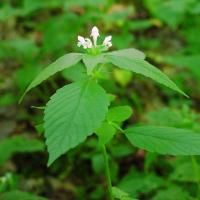Common hempnettle
Galeopsis tetrahit
Introduction: Galeopsis tetrahit, commonly known as common hemp-nettle, is an herbaceous annual plant belonging to the Lamiaceae family. Native to Europe and Asia, it has naturalized in various regions around the world. Despite its classification as a weed in agricultural contexts, common hemp-nettle has ecological roles and some historical uses.
Identification:
1. Morphology:
- Height: Common hemp-nettle typically grows to a height of 30 to 120 centimeters.
- Leaves: The leaves are opposite, serrated, and rough to the touch, with a distinctive triangular shape.
- Stems: Square stems, common in the mint family, are covered with fine hairs.
2. Flowers:
- Inflorescence: The flowers are arranged in whorls, forming spikes at the ends of branches.
- Color: The tubular flowers can be pink, purple, or white.
3. Habitat:
- Common hemp-nettle thrives in disturbed areas, including fields, roadsides, and waste grounds.
- It adapts to a variety of soil types and is commonly found in nitrogen-rich environments.
Ecological Roles:
1. Pollinator Attraction:
- The flowers attract pollinators, such as bees and butterflies, contributing to local biodiversity.
2. Soil Stabilization:
- The extensive root system of common hemp-nettle helps prevent soil erosion in disturbed areas.
3. Nitrogen Accumulation:
- Like other members of the mint family, common hemp-nettle can accumulate nitrogen in its tissues.
Invasive Characteristics:
1. Aggressive Growth:
- Common hemp-nettle is known for its rapid growth and ability to form dense stands, outcompeting other vegetation.
2. Seed Production:
- The plant produces numerous seeds, contributing to its prolific and widespread colonization.
Control and Management:
1. Cultural Practices:
- Maintaining healthy vegetation and minimizing soil disturbance can help suppress common hemp-nettle growth.
- Crop rotation and proper soil management may reduce its prevalence in agricultural fields.
2. Herbicide Use:
- Selective herbicides targeting broadleaf weeds can be employed for control in agricultural settings.
- Care must be taken to avoid damage to desirable crops and plants.
3. Manual Removal:
- Hand-pulling or mowing before seed production can be effective for small infestations.
- Ensuring the removal of the entire plant, including the roots, helps prevent regrowth.
4. Biological Control:
- Some insects and pathogens have been investigated as potential biocontrol agents for common hemp-nettle.











